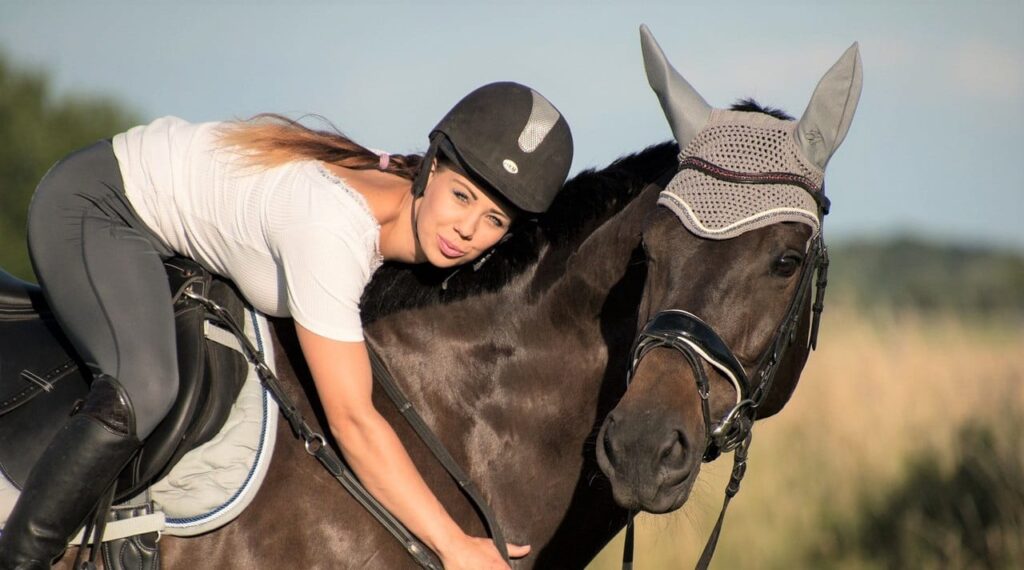Horsemanship Tips – Mastering The Art Of Horse Care And Training!
The skill of comprehending, training, and maintaining horses is known as horsemanship. Whether you’re a beginner or an experienced rider, mastering horsemanship tips can transform your relationship with your horse.
Horsemanship tips help riders build trust and communication with their horses. Focus on patience, consistency, and clear cues. Proper grooming, feeding, and training techniques improve your bond. Stay calm, use positive reinforcement, and always prioritize safety.
Learning how horses think, communicate, and respond helps create a bond based on trust and respect.
Understanding Horse Behavior!
Horses are intelligent animals with their own way of communicating. They use body language, vocal sounds, and subtle cues to express their emotions. Recognizing behaviors such as pinned ears, tail swishing, or relaxed posture can help you understand what your horse is feeling. By paying attention to these cues, you can build a stronger connection and prevent misunderstandings.
Building Trust with Your Horse!
Building a good relationship between a horse and its rider is the key to riding and working together successfully. To create this bond, spend time with your horse in different ways, not just riding. Grooming is a great way to build trust because it helps the horse feel comfortable with your touch. Walking your horse by hand also strengthens your connection, as it allows the horse to follow your lead and get used to being with you. Doing simple groundwork exercises, like leading in different directions or asking the horse to stop and start, can help develop good communication. When you spend time together in a calm and patient way, your horse will learn to trust you more and feel safe around you.

Always approach your horse in a gentle and relaxed manner so that it feels at ease. Speak in a soft and soothing voice, as loud or sudden sounds might make the horse nervous. When your horse listens to you and behaves well, reward it with a treat or a kind pat to reinforce good behavior. Horses respond well to positive encouragement, so showing appreciation helps them understand what you want. Over time, with patience and care, your horse will feel comfortable with you and become more willing to follow your guidance. A strong bond built on trust and kindness makes working together much easier and more enjoyable for both the rider and the horse.
Essential Horsemanship Skills!
1. Basic Skills for Good Horsemanship:
Good horsemanship starts with learning the basics. You need to sit properly, keep your balance, and handle the horse the right way. These skills help you stay safe and in control while riding.
2. How to Communicate with Your Horse:
To communicate well with your horse, you should know how to lead it correctly, sit steadily while riding, and use the reins the right way. These simple techniques help your horse understand what you want it to do.
Basic Groundwork Techniques!
- Groundwork is key – It lays the foundation for training and respect between horse and handler.
- Start with simple groundwork – Exercises like yielding to pressure help improve behavior.
- Use lunging for discipline – It teaches obedience and responsiveness.
- Encourage controlled movement – Guide your horse to move with balance and precision.
- Practice consistency – Regular groundwork builds trust and reinforces good habits.
- Focus on communication – Clear cues help your horse understand what you expect.
- Stay patient and calm – Horses learn best when training is stress-free and positive.
Training a Horse with Positive Reinforcement!
Horses learn best when they experience the same training methods regularly and receive positive feedback. If a horse does something right, giving it a treat, a gentle pat, or kind words helps it understand that it has done well. When a horse is rewarded for good behavior, it is more likely to repeat the same action.
This approach makes training easier and builds a strong bond between the horse and its trainer. Horses respond well to kindness and patience, so using rewards makes learning enjoyable for them.
It is important to avoid harsh punishments because they can make a horse scared and less trusting. If a horse is punished too much, it may become confused or nervous, making training more difficult. Instead of using fear, trainers should focus on encouragement and clear guidance.
Read: Symley – An In-Depth Exploration!
Handling Difficult Horses!
- Some horses may be nervous or aggressive due to past experiences or lack of training.
- Always approach nervous or aggressive horses with patience and confidence.
- Move slowly and avoid sudden movements to prevent startling the horse.
- Speak in a calm, reassuring tone to build trust.
- Allow the horse to observe and get familiar with your presence before making contact.
- Use desensitization training to help the horse become comfortable with new experiences.
- Gradually expose the horse to stressful situations in a controlled manner.
- Reward calm behavior with treats, gentle strokes, or soothing words.
- Avoid forcing interactions; let the horse come to you when it feels safe.
- Work with an experienced trainer if the horse shows extreme fear or aggression.
- Be consistent and patient, as trust-building takes time.
- Always prioritize safety for both yourself and the horse.
Riding Techniques for Beginners
1. Learn to Get On and Off the Horse Safely:
If you are new to horseback riding, start by learning how to get on and off the horse safely. Always use a mounting block if needed and hold the reins gently. Getting off should be slow and steady to avoid falling.
2. Keep Your Balance While Riding:
A balanced seat helps you stay safe and comfortable while riding. Sit up straight, keep your heels down, and relax your body. Good balance makes it easier to control the horse and enjoy the ride.
3. Use the Reins Gently:
Reins help you guide the horse, but pulling too hard can confuse or hurt the horse. Hold the reins lightly and use soft movements to turn or stop. Gentle rein control makes riding smoother and better for both you and the horse.
Common Mistakes in Horsemanship and How to Avoid Them!
Many people make mistakes when working with horses, and one of the biggest is ignoring the horse’s body language. Horses communicate through their movements, ears, and facial expressions, so it is important to pay attention. If a horse is feeling nervous, confused, or uncomfortable, it will show signs such as pinned ears, a swishing tail, or stepping away. If these signs are ignored, the horse may become frustrated or even scared.
Overcorrecting a horse’s behavior without understanding why it is acting that way can create more problems. Instead of helping the horse learn, too much correction can make it anxious or unsure. Using inconsistent cues can also cause confusion because the horse won’t know what is expected. For example, if you ask the horse to stop but sometimes pull on the reins hard and other times do it gently, the horse may not understand what you want. This can lead to stress and miscommunication between the horse and the rider.
Grooming and Horse Care!
1. Grooming Keeps Your Horse Healthy:
Regular grooming is important for your horse’s health. Brushing helps remove dirt and loose hair, keeping the coat clean. Taking care of the hooves prevents infections and keeps your horse comfortable.
2. Make Grooming a Daily Habit:
Grooming your horse every day helps build a strong bond. It also keeps your horse clean and healthy. A daily routine ensures your horse stays comfortable and well cared for.
Horse Nutrition and Feeding Guidelines!
- Ensure your horse has a well-balanced diet for optimal health.
- Feed high-quality hay as a primary food source.
- Always provide fresh, clean water.
- Choose appropriate grains based on your horse’s age and activity level.
- Avoid sudden changes in diet to prevent digestive problems.
- To keep the digestive system from being irritated, introduce new foods gradually.
- Monitor your horse’s weight and adjust feed portions accordingly.
- Provide salt or mineral blocks for essential nutrients.
- Feed at consistent times each day to maintain a routine.
- Consult a veterinarian or equine nutritionist for diet recommendations.
Equine Health and Veterinary Care!
Taking care of your horse’s health is very important, and regular visits to the vet help keep your horse in the best condition. A vet can check for any health problems early and give the right treatment before they get worse. Horses need proper care, food, and exercise, but even with the best care, they can sometimes get sick. That’s why it’s important to keep an eye on your horse every day. If you notice anything unusual, such as a change in behavior or how they move, it might be a sign that something is wrong. Regular check-ups help prevent serious health issues and make sure your horse stays strong and active for a long time.

It is also important to look out for warning signs that your horse might not be feeling well. If your horse starts losing weight, has a dull or rough coat, or does not eat as usual, these could be signs of illness. Other signs, such as being less active, acting differently, or looking uncomfortable, should not be ignored. If you notice any of these symptoms, calling a vet quickly is the best thing to do. Getting medical help on time can prevent bigger problems and help your horse recover faster. By paying attention to your horse’s health and getting proper care when needed, you can ensure a long, happy, and healthy life for your horse.
Choosing the Right Equipment and Tack!
1. Saddle, Bridle, and Bit for Comfort and Control:
Having the right saddle, bridle, and bit is very important for both you and your horse. A well-fitting saddle helps you sit comfortably and stay balanced while riding. The bridle and bit should also fit well to give you better control without hurting your horse. Always check your tack before riding to make sure it fits properly.
2. Poorly Fitting Tack Can Cause Problems:
If your saddle, bridle, or bit does not fit correctly, it can make your horse uncomfortable. This can lead to pain, irritation, and even bad behavior. A poorly fitting saddle can cause sores, while the wrong bridle or bit may make your horse resist commands. Always take the time to adjust your tack to keep your horse happy and safe.
Read: Vandyworks – Your Ultimate Guide To Innovative Solutions!
FAQs:
1. How much time does it take to become a skilled horseman?
Horsemanship is a lifelong journey. While basic skills can be learned in months, true mastery takes years of consistent practice.
2. What are the best books on horsemanship?
Some great books include “The Complete Training of Horse and Rider” by Alois Podhajsky and “Think Like a Horse” by Grant Golliher.
3. How can I determine whether my horse has faith in me?
A trusting horse will follow you, remain calm in your presence, and respond positively to your cues.
4. What is the best way to train a young horse?
Start with groundwork exercises and gradually introduce saddle training. Be patient and use positive reinforcement.
5. How do I improve my confidence in horse riding?
Practice regularly, work with an experienced trainer, and stay relaxed while riding.
Conclusion:
Mastering horsemanship takes time, patience, and practice. By following these horsemanship tips, you can develop a strong and trusting relationship with your horse while improving your riding skills. Stay consistent, keep learning, and enjoy the rewarding journey of working with horses.
Also Read:
- 4t Gasto 9.5 Millones En Busqueda De Catalino – A Comprehensive Look At The Case!
- Chliphot – A Journey Into The Art Of Photography!
- Geekzilla Podcast – A Deep Dive Into Pop Culture, Gaming, And Tech!
- Instanavigation – Your Guide To Discreet Instagram Story Viewing And More!
- Www.Unfgaming.Net Blog – Exploring The World Of Online Gaming!



































































Post Comment